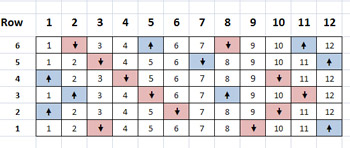 I am revisiting this post on Celtic Knot Textiles because of my participation in the Inkle Weaving Workshop I’ve been doing with Steve Kennett at the Online Guild. Also see Sara Lamb’s Celtic Knotwork.
I am revisiting this post on Celtic Knot Textiles because of my participation in the Inkle Weaving Workshop I’ve been doing with Steve Kennett at the Online Guild. Also see Sara Lamb’s Celtic Knotwork.
I’ve always found pick up labourious. Even though the results are worth it. It seemed that the arrangement of Steve’s working patterns made the pick up easier and quicker. But why? I looked at how I structure my working pattern notes in comparison to Steve’s method and found some fundamental clues to good instructional design. It’s the human mind at work. It’s also the availability of computer programs to more of us. Allowing us to present information in a more highly visual way.
![]() This is the warping diagram for this Celtic Knot pattern. The P’s represent a thicker warp for the pattern followed each time by two thinner threads on the open and heddles. Steve also had a better visual and symbolic style of writing warping patterns but I haven’t included it here.
This is the warping diagram for this Celtic Knot pattern. The P’s represent a thicker warp for the pattern followed each time by two thinner threads on the open and heddles. Steve also had a better visual and symbolic style of writing warping patterns but I haven’t included it here.
 The first pattern diagram is the type I usually use and is a common convention. It provides a reasonable visual of how the pattern will look (axonometric graph paper is even better for this), which is valuable. The diagram only focuses on the pattern threads as the others take care of themselves with the shedding device on the inkle loom. Starting at the bottom, with the UP shed, you can see 12 pattern threads at our disposal for manipulation into a design. But that is where the working diagram ends. It’s up to the weaver to figure out on each row which pattern threads should be picked up or dropped down. So every row I have to refocus attention. I usually convert this pattern gird to written notation like 2,1,5,1,2,1, for each row so my fingers can work quickly through the threads but if we see things in a direct visual way it saves the struggle. This type of diagram is effective for showing a representation of how the weave will look and contains the information for weaving it but doesn’t really assist us greatly in actually weaving each row….the working diagram.
The first pattern diagram is the type I usually use and is a common convention. It provides a reasonable visual of how the pattern will look (axonometric graph paper is even better for this), which is valuable. The diagram only focuses on the pattern threads as the others take care of themselves with the shedding device on the inkle loom. Starting at the bottom, with the UP shed, you can see 12 pattern threads at our disposal for manipulation into a design. But that is where the working diagram ends. It’s up to the weaver to figure out on each row which pattern threads should be picked up or dropped down. So every row I have to refocus attention. I usually convert this pattern gird to written notation like 2,1,5,1,2,1, for each row so my fingers can work quickly through the threads but if we see things in a direct visual way it saves the struggle. This type of diagram is effective for showing a representation of how the weave will look and contains the information for weaving it but doesn’t really assist us greatly in actually weaving each row….the working diagram.
 In contrast Steve’s diagrams actually inform you about the process. Only the affected pattern threads on each row are marked and the notation tells you whether the pattern thread is picked up or dropped down. Steve has also used colour to further alert us to the rhythm of the pattern. This type of notation is a true working pattern diagram but doesn’t display the ‘look’ of the completed weave very well. It’s a great format to work directly onto the loom.
In contrast Steve’s diagrams actually inform you about the process. Only the affected pattern threads on each row are marked and the notation tells you whether the pattern thread is picked up or dropped down. Steve has also used colour to further alert us to the rhythm of the pattern. This type of notation is a true working pattern diagram but doesn’t display the ‘look’ of the completed weave very well. It’s a great format to work directly onto the loom.

Leave a Reply